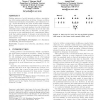Free Online Productivity Tools
i2Speak
i2Symbol
i2OCR
iTex2Img
iWeb2Print
iWeb2Shot
i2Type
iPdf2Split
iPdf2Merge
i2Bopomofo
i2Arabic
i2Style
i2Image
i2PDF
iLatex2Rtf
Sci2ools
KDD
2006
ACM
2006
ACM
A framework for analysis of dynamic social networks
Finding patterns of social interaction within a population has wide-ranging applications including: disease modeling, cultural and information transmission, and behavioral ecology. Social interactions are often modeled with networks. A key characteristic of social interactions is their continual change. However, most past analyses of social networks are essentially static in that all information about the time that social interactions take place is discarded. In this paper, we propose a new mathematical and computational framework that enables analysis of dynamic social networks and that explicitly makes use of information about when social interactions occur. Categories and Subject Descriptors: I.6.5 Simulation and Modeling: Model Development
| Added | 30 Nov 2009 |
| Updated | 30 Nov 2009 |
| Type | Conference |
| Year | 2006 |
| Where | KDD |
| Authors | Tanya Y. Berger-Wolf, Jared Saia |
Comments (0)

